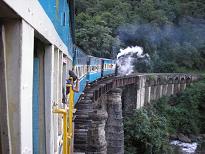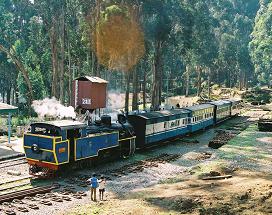 It was in 1602 when Jacome Ferrieri, a Syrian Christian priest first stumbled upon the wild forest areas of the Nilgiri Mountains.It was the first time that the beauty of the blue mountains was discovered by the outside world. But the tiresome climb to the mountains prevented people from visiting it till mid 1800s. It was left to the then District Engineer of Nilgiris, Mr.J.L.L.Morrant, to conceptualise a mountain Railway.
It was in 1602 when Jacome Ferrieri, a Syrian Christian priest first stumbled upon the wild forest areas of the Nilgiri Mountains.It was the first time that the beauty of the blue mountains was discovered by the outside world. But the tiresome climb to the mountains prevented people from visiting it till mid 1800s. It was left to the then District Engineer of Nilgiris, Mr.J.L.L.Morrant, to conceptualise a mountain Railway.
It was in 1854 when proposals were first mooted by the British to build a railway up the hills from Mettupalayam. After several proposals and attempts by various companies to start the line, it was finally left to M.Riggenback, the Swiss inventor of the Rigi system, who gave final shape to Nilgiri Mountain Railway in 1880s. Work on the Mettupalayam – Coonoor line started in 1891. By the time the section from Mettupalayam to Coonoor was officially opened by the Governor of Madras on August 11, 1898, the line had already changed hands thrice, each time a new company being formed due to the liquidation of the earlier one. The Mettupalaiyam – Coonoor section was thrown open to public traffic on June 15, 1899 and on January 1, 1903 the line was taken over by the Indian Government. The Coonoor – Fernhill section was opened on 15-9-1908, and the Coonoor – Ooty section was opened on 15-10-1908.
Geography of the Nilgiri Mountain Railway line
Situated between 8° 5′ North and 13° 35′ North and between 76° 15′ East and 80° 20′ East, the Nilgiri Mountain Railway is a 45.88 km stretch from Mettupalayam to Udhagamandalam. Udagamandalam which is also known as Ooty is at an elevation of 2200 metres above Mean Sea Level. Coonoor which is between Mettupalayam and Udagamandalam, is 6000 feet above the Sea at the South East Corner of the Nilgiri Plateau, and at the head of the principal pass from the plains. The 45.88 km long Railway line from Mettupalayam to Udhagamandalam lies partly in Coimbatore District and partly in Nilgiri District of Tamil Nadu, on the eastern slopes of the Western Ghats. The line passes through eight stations namely Mettupalayam, Hillgrove, Coonnor, Wellington, Aravankadu, Ketti, Lovedale and Udagamandalam.
The Route
The ‘Nilagiri Passenger’ train covers a distance of 26 mi (41.8 km),[2] travels through 208 curves, 16 tunnels, and 250 bridges. The uphill journey takes around 290 minutes (4.8 hours), and the downhill journey takes 215 minutes (3.6 hours) It has the steepest track in Asia with a maximum gradient of 8.33%.An excited crowd receives the Nilgiri Mountain Train at Ooty station A journey by the NMR provides spectacular views of the Nilgiri Hills
- Mettupalayam – 0 km (0 mi), 1,069 ft (325.8 m) above sea level – Junction with the 5 ft 6 in (1,676 mm) (Indian Gauge) line from Coimbatore. Passengers cross the platform to board the Nilagiri Passenger train (NMR). There is a small locomotive shed here and also the carriage workshops for the line. Leaving Mettupalayum, the line is adhesion worked and actually drops for a short distance before crossing the Bhavani River, after which it starts to climb gently.
- Kallar – 8 km (5 mi), 1,260 ft (384 m) – Closed as a passenger station, this is where the rack rail begins. As the train leaves the station, the gradient is 1 in 12 (8.33%).
- Adderly – 13 km (8.1 mi), 2,390 ft (728.5 m) – Closed as a passenger station but is still a water stop.
- Hillgrove – 18 km (11.2 mi), 3,580 ft (1,091.2 m) – Block post and water stop, also has refreshments for passengers.
- Runneymede – 21 km (13 mi), 4,612 ft (1,405.7 m) – Closed as a passenger station but is still a water stop.
- Kateri Road – 25 km (15.5 mi), 5,070 ft (1,545.3 m) – Closed as a passenger station, trains do not stop here.
- Coonoor – 28 km (17.4 mi), 5,616 ft (1,711.8 m) – main intermediate station on the line at site of the locomotive workshops as well as the top end of the rack rail. Trains must reverse a short distance before continuing their climb to Ooty. It is normal for the locomotive to be changed here with diesel traction, being normal for all trains to Ooty.
- Wellington – 29 km (18 mi), 5,804 ft (1,769.1 m)
- Aruvankadu – 32 km (19.9 mi), 6,144 ft (1,872.7 m)
- Ketti – 38 km (23.6 mi), 6,864 ft (2,092.1 m)
- Lovedale – 42 km (26.1 mi), 7,694 ft (2,345.1 m) From a short distance before Lovedale, the line descends into Ooty.
- Ooty – 46 km (28.6 mi), 7,228 ft (2,203.1 m).).
MORE ABOUT US
click abvove to know
more about nilgiri railway
